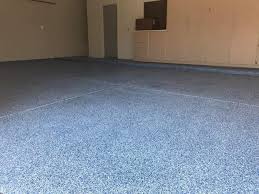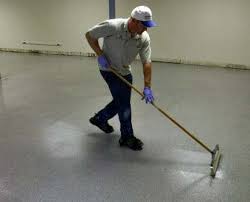How can I make my epoxy floor shine again?
For regular cleaning of your epoxy floor, a simple dust mop will work wonders. Applying your dust mop around once a week is the best way to clean epoxy floors and to gather up strangling dust or dirt. If desired, you can also take a hose to wash down your entire floor and then use a squeegee to absorb the residue. Every three or four months a more vigorous scrub may be required to obtain a clean epoxy floor. This is especially the case when your floor is heavily trafficked by vehicles or machinery. You’ll need a hard foam mop, as a string mop will leave streak marks and will not clean your epoxy floors with the most efficiency. If your floor is subject to outdoor elements entering such as rain, sleet, or snow then ensure you clean your floor vigorously at least one time per month.

Making Epoxy Floors Shine
Prevention Is the Key
Although there are many types of epoxy flooring, epoxy is made with many layers of coating that makes it durable. However, you can damage the material without proper care. While using any furniture, cycle, or similar things, you can use protective pads to avoid scratching. Even though the material is scratch-resistant; you can take some precautionary measures to maintain the look for a long.
Regular Cleaning
A simple cleaning can make help your flooring retain the shine and to boost the aesthetic appeal. When there is any spill on the floor, you can simply wipe using a soft cloth. Also, you can use a broom or vacuum to get rid of dust and debris. You can avoid regular cleaning by investing in color chip epoxy floors.
How to Remove Stains
In addition to regular cleaning, you will have to take extra caution to remove engine oil. If you find engine oil or similar kind of stains on the floor, use a solution made with the mixture of water and ammonia to get rid of it fast. Treat the stain as soon as you notice to get a more effective result.
For cleaning, first, sweep the visible dust and then soak your mop in the solution (gallon of hot water and five ounces of ammonia) and wipe the area completely. It will remove almost all types of stains without affecting the coating. You might need light scrubbing for some specific types of stains. You can use a soft kitchen scrubbing pad to scrub the stain with hot water. You should avoid using abrasive cleaners as it can damage the flooring.

When to Recoat
Once again, epoxy floors are very low maintenance and require just the basic cleaning in order to stay in shape. However, a time may come in several years when the shine can’t be restored with routine cleaning. If your coating has lost its luster, it may be time for a recoat.
You can do this process on your own, if you wish. However, depending on the size of your space, it may be best to leave the recoating to the professionals. The work includes buffing and sanding the previous coating, filling in any cracks or gouges, properly cleaning the floor and then applying the coat of epoxy. It is a technical process that can be an arduous task, especially for large areas, such as warehouses and manufacturing facilities.

High-gloss flooring maintenance options
When I first started looking at maintenance for my high-gloss floors many years ago, I began with side-by-side tests of three common options: epoxies, polyurethanes (PU) and sacrificial polishes. I’ll define a sacrificial polish as an acrylic or wax emulsion that’s typically applied with a mop and buffed to increase its durability and shine. In my very simple way of looking at it, which one to use would more or less boil down to how well they resisted day-to-day scuffing, scratching, spills and the like – you know, the usual wear and tear that gradually dulls a beautiful high-gloss floor.
From what I saw in those tests and have experienced since, the best of these finishes when it came to maintaining the original finish was a PU. From that, it might seem logical to conclude that a PU should be applied wherever possible and rest can be forgotten. Well, in my opinion, this isn’t quite the case and PUs aren’t always the solution to high-gloss flooring maintenance. In fact, I prefer to use a floor polish more times than not.
Easier Than You Thought
Routine Cleaning
Water is essential for any cleaning task. Routine maintenance of any type of epoxy floor involves pouring water on it, then drying the surface. Hot water does a great job. Pour it on the surface through a hosepipe then dry the floor. If there are spots that require extra attention, use a cleaner and a piece of cloth to wipe the affected area.
Vacuuming takes care of dust and other particles on the floor. You can also use a broom or mop during cleaning.
Annual Cleaning
It is fine to clean your epoxy floor thoroughly once a year. However, if a lot happens on the floor, then cleaning after six months would be a great idea. Doing so prevents the buildup of dirt and the formation of tough stains that are hard to clean. With annual cleaning, mix water and ammonia for satisfactory results. That epoxy floor will shine and look as good as new.
How often you clean the floor depends on foot traffic. For example, a commercial building epoxy floor that has many people going in and out requires frequent cleaning than a floor in your home.
Reducing Damage on Epoxy Floors
Epoxy floors are prone to wear and tears among other damages. There is always something that you can do to reduce the extent of the damage. This increases the durability of the floor and keeps it shining.
For instance, if you have a garage with this kind of floor, there are a few habits to adopt. That bicycle stand should not touch the floor directly. Use a pad on which the stand rests. This will reduce damages such as scratches.
Be creative and find something to place between the stand and the floor. In as much as epoxy floors are tough and scratch resistant, furniture can mess them with streaks and the like. Use padding to prevent damage.
Wipe anything you spill on the epoxy floor immediately using a cloth to prevent unsightly stains.
Cleaning and Maintaining Your Epoxy Coating
Because epoxy coatings are seamless (don’t have any cracks or crevices) and by their very nature repellant to dust, dirt, and are antimicrobial, they make for not only a safer flooring solution but also a cleanlier one.
Whether you have or are interested in applying epoxy to your garage, kitchen, bedroom, or basement, there are a few simple epoxy cleaning rules and methods that will ensure your coating remains beautiful and healthy for years to come.
Here’s a quick overview with a more detailed explanation below:
- Dust & Dirt: Sweep your floors regularly (As needed)
- Washing: Mop your floors weekly to keep them looking great (Some prefer once every 2 weeks – 1 Month)
- Spills & Leaks: Clean any spills and leaks as soon as possible with a cloth or paper towel.
- Heavy Duty Cleaning: Scrub with a foam mop using hot water and clear ammonia
Tip:
- You can also use an electric polishing machine to restore shine to a dull coating if needed.
- Using soap based cleaners can leave a cloudy film on your coating which makes your epoxy seem dull. A good scrubbing can remove this film and is usually the case when a client thinks their epoxy is losing its shine.